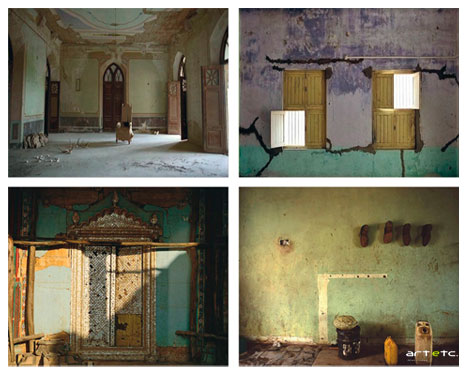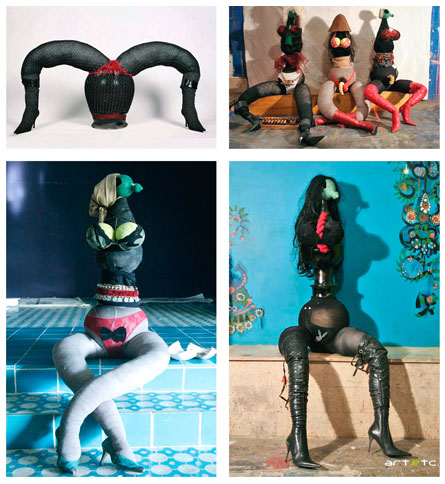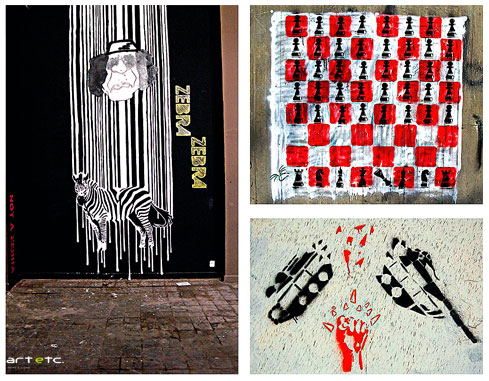- Publisher's Note
- Editorial
- What's Behind This Orange Facade!
- “First you are drawn in by something akin to beauty and then you feel the despair, the cruelty.”
- Art as an Effective Tool against Socio-Political Injustice
- Outlining the Language of Dissent
- Modern Protest Art
- Painting as Social Protest by Indian artists of 1960-s
- Awakening, Resistance and Inversion: Art for Change
- Dadaism
- Peredvizhniki
- A Protected Secret of Contemporary World Art: Japanese Protest Art of 1950s to Early 1970s
- Protest Art from the MENA Countries
- Writing as Transgression: Two Decades of Graffiti in New York Subways
- Goya: An Act of Faith
- Transgressions and Revelations: Frida Kahlo
- The Art of Resistance: The Works of Jane Alexander
- Larissa Sansour: Born to protest?!
- ‘Banksy’: Stencilised Protests
- Journey to the Heart of Islam
- Seven Indian Painters At the Peabody Essex Museum
- Art Chennai 2012 - A Curtain Raiser
- Art Dubai Launches Sixth Edition
- "Torture is Not Art, Nor is Culture" AnimaNaturalis
- The ŠKODA Prize for Indian Contemporary Art 2011
- A(f)Fair of Art: Hope and Despair
- Cross Cultural Encounters
- Style Redefined-The Mercedes-Benz Museum
- Soviet Posters: From the October Revolution to the Second World War
- Masterworks: Jewels of the Collection at the Rubin Museum of Art
- The Mysterious Antonio Stellatelli and His Collections
- Random Strokes
- A ‘Rare’fied Sense of Being Top-Heavy
- The Red-Tape Noose Around India's Art Market
- What Happened and What's Forthcoming
- Art Events Kolkata, January – February 2012
- Mumbai Art Sighting
- Art Bengaluru
- Delhi Dias
- Musings from Chennai
- Preview, February, 2012 – March, 2012
- In the News-February 2012
- Cover
ART news & views
Random Strokes
Issue No: 26 Month: 3 Year: 2012
by Rumi Banerjee
Haunted by Layered Histories
She stole a sky from the clouded silence...
 For a moment the enigmatic ordeal of existence, all the rush and worries, miracles of memories all stopped...the sound of silence whispers in the ear... all those stories untold...unrealised...and long forgotten. Her space creates a psychological vacuum, a feeling of being nowhere....a feeling of ‘once there was’...some unarticulated thoughts merged with the vast sea of time. A sense of void memory and unappreciated life hover her works. The play with sun and shades, the faint orange melancholic sunlight of dusk, an absent gaze perhaps... woven in all the photographs of Zarina Bhimji. Her spaces become living breathing characters and protagonists of her stories. Her photographs can rightly be called mindscapes, a record of collapsed time and memories...a maddening silence stares out of the windows...everything is so still...empty...crossing the edge of secret ...as if time lies as a keychain on the night table.
For a moment the enigmatic ordeal of existence, all the rush and worries, miracles of memories all stopped...the sound of silence whispers in the ear... all those stories untold...unrealised...and long forgotten. Her space creates a psychological vacuum, a feeling of being nowhere....a feeling of ‘once there was’...some unarticulated thoughts merged with the vast sea of time. A sense of void memory and unappreciated life hover her works. The play with sun and shades, the faint orange melancholic sunlight of dusk, an absent gaze perhaps... woven in all the photographs of Zarina Bhimji. Her spaces become living breathing characters and protagonists of her stories. Her photographs can rightly be called mindscapes, a record of collapsed time and memories...a maddening silence stares out of the windows...everything is so still...empty...crossing the edge of secret ...as if time lies as a keychain on the night table.
India and East Africa are the repeat locations for Zarina Bhimji’s photographs and large-scale film installations of poetic foray into the archaeology of place. This first major survey exhibition traces 25 years of Bhimji’s work. It opens with the premiere of her long-awaited film, Yellow Patch (2011), motivated by trade and migration across the Indian Ocean. Desolate yet stunning close-up images of deserted Haveli palaces and colonial offices in Mumbai harbour give way to atmospheric renditions of the desert and the sea, along with an evocative soundtrack. Yellow Patch complements the renowned film Out of Blue (2002), an arresting visual journey across Uganda, its elegiac terrain disturbed by the sound of fire, birds and human voices. She was born to Indian parents, in Mbarara, Uganda in 1963. Later, in 1974, she moved to Britain. She was nominated for the Turner Prize in 2007.
Strange Gods
Shirin’s woman cannot stand on their own…
 Born in 1973 in Tehran, Iran, Shirin Fakhim introduces absurd and sympathetic humour to deal with the issues that proximate the Persian working girls circuit. Exposing the hypocrisy of the sex industry with a serious approach and sprinkling some humour at the same time makes her creations poignant. Her life size assemblages are created of readymade traditional terracotta pot of various shapes and sizes that are used as body parts. The pots are then dressed in fabrics, wigs, high heel boots and different accessories brought from public market, second hand shops and bazaar. Some of her life-sized sculptures are dressed in her own clothes. Around 2002 it was estimated that there were hundred thousand prostitutes working in Tehran despite Iran’s international status as a moralistic country with especially high standards placed on women when most of these women were driven to prostitution because of the abusive domestic situations and the poverty, which resulted from the massive loss of men during the war. In response to Iran’s austere religious laws, some even consider the profession as a civil protest. Her assemblages are misshapen configurations, exaggerating rough trade stereotypes of wig wearing, melon-chested crammed into poorly fitting lingerie. Fakhim ridiculously combines westernized hooker fashion with the codes of Islamic demure. Almost all her characters lack hands depicting social disability. While colourful on the outside, the inside has been painted entirely black and it looks like the woman is trying to pull herself out of the pot. Fakhim is a self-taught artist and she lives and works in Tehran. Her work has been exhibited in London, Rome, New York and many other places as well.
Born in 1973 in Tehran, Iran, Shirin Fakhim introduces absurd and sympathetic humour to deal with the issues that proximate the Persian working girls circuit. Exposing the hypocrisy of the sex industry with a serious approach and sprinkling some humour at the same time makes her creations poignant. Her life size assemblages are created of readymade traditional terracotta pot of various shapes and sizes that are used as body parts. The pots are then dressed in fabrics, wigs, high heel boots and different accessories brought from public market, second hand shops and bazaar. Some of her life-sized sculptures are dressed in her own clothes. Around 2002 it was estimated that there were hundred thousand prostitutes working in Tehran despite Iran’s international status as a moralistic country with especially high standards placed on women when most of these women were driven to prostitution because of the abusive domestic situations and the poverty, which resulted from the massive loss of men during the war. In response to Iran’s austere religious laws, some even consider the profession as a civil protest. Her assemblages are misshapen configurations, exaggerating rough trade stereotypes of wig wearing, melon-chested crammed into poorly fitting lingerie. Fakhim ridiculously combines westernized hooker fashion with the codes of Islamic demure. Almost all her characters lack hands depicting social disability. While colourful on the outside, the inside has been painted entirely black and it looks like the woman is trying to pull herself out of the pot. Fakhim is a self-taught artist and she lives and works in Tehran. Her work has been exhibited in London, Rome, New York and many other places as well.
Upset Them and Make Them Think!
Always to look life in the face and to know what it is...to love life for what it is...for one cannot get peace by avoiding life...
 “It all started on 26 January, when I was at a protest. I thought that even if the revolution did not succeed, there should be traces of it left for people to see. I never did any street art before, and stencil was a good compromise because it was quick and easy. I started with a picture of Mubarak, which was great fun. On the street, we simply could not talk freely, especially not about Mubarak. Through street art, freedom of expression moved from virtual space to the real world.”-- El Teneen
“It all started on 26 January, when I was at a protest. I thought that even if the revolution did not succeed, there should be traces of it left for people to see. I never did any street art before, and stencil was a good compromise because it was quick and easy. I started with a picture of Mubarak, which was great fun. On the street, we simply could not talk freely, especially not about Mubarak. Through street art, freedom of expression moved from virtual space to the real world.”-- El Teneen
El Teneen’s works colour the bleak walls of the Cairo Metropolis yet they also have a strong political air. A novice in the street art scene, his stencils, such as the chessboard image on the wall of the American University in Cairo, have become icons of 25th January Revolution. At the beginning, there was a pair of young street artists that constituted “Team El Teneen”...now the anonymous stencil artist is pretty much by himself.
Earlier to the revolution, he focussed his creativity to abstract painting, although his studies were closer to the field of science, he refuses to reveal too much about his life. From the beginning of the revolution, however he has taken part in street art, a new trend, getting himself entangled in Egyptian politics by accident. However, he is an apolitical by nature but somehow events made him react and he felt an inner push to talk about it. He has no theme in general, but his works will make the viewer think. While doing graffiti people generally do not care about who he is as he is anonymous but people have their own interpretations. His famous chessboard image has several interpretations. According to his own interpretations means that something has changed, when all the pawns are on one side, the king is upside down, and the people who are with the revolution are with the pawns and the high ranking officials are still on the side of the ousted king. He would also like to transform his work into something more social and provocative.
Like Every Day
She uses regular kitchen stuff for her creations…
 Born in 1974 in Tehran, Iran Shadi Ghadirian is a photographer who lives and works in Iran. She studied photography at Azad University in Tehran. Her photographs are closely related to her identity as a Muslim woman living in Iran. Her art also deals with issues relevant to women living in other parts of the world. She explores ideas of censorship, religion, modernity, and the universal status of women. She challenged the international preconceptions of women’s role within an Islamic state, with her own experiences as a modern woman living within the archaic codes of Sharia law. Her images describe a positive and holistic feminine identity, humorously adopting the themes of the traditional roles bestowed on them especially by which women in the Middle East and women in general have been defined. In Like Every Day series, Ghadirian comments upon the daily repetitive routine to which women are confined willingly and which define them. Each of these colour photographs depicts a figure draped in patterned fabric in place of the typical Iranian chador. However, instead of a face, each figure has a common household item that symbolize the personality of a woman, such as an iron, a colander, a teacup, a broom, a pot or a pan or maybe even a grater-faced woman, perhaps embodying the personality of a mother-in-law. Through her works, she questions the role of a woman in the society. She identified women and their position in society as mere homemakers with their life confined inside a kitchen.
Born in 1974 in Tehran, Iran Shadi Ghadirian is a photographer who lives and works in Iran. She studied photography at Azad University in Tehran. Her photographs are closely related to her identity as a Muslim woman living in Iran. Her art also deals with issues relevant to women living in other parts of the world. She explores ideas of censorship, religion, modernity, and the universal status of women. She challenged the international preconceptions of women’s role within an Islamic state, with her own experiences as a modern woman living within the archaic codes of Sharia law. Her images describe a positive and holistic feminine identity, humorously adopting the themes of the traditional roles bestowed on them especially by which women in the Middle East and women in general have been defined. In Like Every Day series, Ghadirian comments upon the daily repetitive routine to which women are confined willingly and which define them. Each of these colour photographs depicts a figure draped in patterned fabric in place of the typical Iranian chador. However, instead of a face, each figure has a common household item that symbolize the personality of a woman, such as an iron, a colander, a teacup, a broom, a pot or a pan or maybe even a grater-faced woman, perhaps embodying the personality of a mother-in-law. Through her works, she questions the role of a woman in the society. She identified women and their position in society as mere homemakers with their life confined inside a kitchen.
Her works have been exhibited in museums and galleries across Europe, and the U.S.A. She has also been featured in print and electronic media (including the New York Times, Photography Now, the Daily Telegraph, the BBC and others). Her works are in the collection of the Los Angeles County Museum of Art, among others.